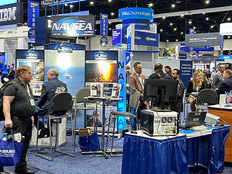DOJ, Interior Plan for Next-Generation Telecommunications as EIS Contract Looms
Sometime this spring, the General Services Administration expects to award its Enterprise Infrastructure Solutions contract, a $50 billion, 15-year telecommunications infrastructure vehicle. GSA and other agencies are getting ready, with the Justice Department seeking industry input on how it can best make the transition to EIS, and the Interior Department seeking information on how to augment EIS with more voice services.
In the meantime, GSA is trying to make the transition as smooth as possible. EIS is a massive undertaking that will provide mission-critical telecommunications infrastructure and will replace the government’s Networx, Washington Interagency Telecommunications (WITS) 3, and local telecommunications services contracts.
Agencies will take advantage of next-generation networking technology through EIS — including software-defined networking and 5G wireless networks — for the foreseeable future. The EIS is expected to extend until 2032, with technology continually updated and refreshed under the contract and time built in at the contract’s end for a transition to a new vehicle.
Agencies are expected to shift away from the Networx contract by the spring of 2020. Amando Gavino, director of GSA's Office of Network Services Programs, told FCW the EIS contract is designed to be a total solutions vehicle that embraces “the full array of enterprise infrastructure services and capabilities necessary for an agency to fulfill its overall telecom requirements.”
GSA Plans for the EIS Transition
As FCW notes, the massive EIS contract covers 53 agency customers, more than 8,000 subagencies and around 16,000 customer accounts. The government spends about $2 billion per year in telecommunications services, and 8 million line items will need to be moved off old contracts to EIS. GSA wants to make the transition to EIS smoother than the one from FTS 2001 to Networx, which took six years and cost more than the government had anticipated.
FCW reports: “In the process, agencies had to adapt to an increasingly dramatic technological shift in the larger world as traditional wireline telephone services accelerated toward digitally oriented, smartphone-centric and app-driven technology. Some agencies were not prepared for the technological leap.”
GSA is hoping to have a smoother transition, which is already under way in many respects. “Transition is scheduled for three years, whereas Networx was done in six years,” Gavino said. “That’s double the business volume in half the time. Transition is a critical project, and we are constantly looking for ways to mitigate risks with the agencies.”
GSA has already unified its 11 regional network services programs and offices into a single national program, FCW notes, and in January, the agency issued a request for information on how to structure transition contracts for those 11 regions.
DOJ Seeks Input on Enterprise Voice Services
Agencies are trying to get ahead of the transition. The Justice Department said in a recent request for information that it “will leverage the EIS contract vehicle upon award for telecommunication services” but that it is seeking information on how best to make the transition for enterprise voice services.
DOJ said it “envisions maintaining current legacy services in the initial transition to EIS (like for like) leveraging existing equipment with a roadmap to an end state of a fully developed, modern infrastructure platform based upon” Voice over IP, IP telephony and unified communications technologies.
Those technologies will “provide greater degrees of flexibility and opportunities to reduce operating costs.” The Justice Department said that after the transition, it “envisions the integration of multiple methods of communication to allow users to connect, collaborate, and exchange information. This may include real-time and non-real-time, ‘one-to-one,’ ‘one-to-many,’ and ‘many-to-many’ bi-directional communications between internal and external entities.”
The Justice Department plans to use unified communications services potentially as an application hosted by the contractor that supports multiple users over an IP network, or as a premises-based, hosted, or some kind of hybrid solution. DOJ said the solution should support IP phones, mobile phones, web browsers, email clients, desktop clients, PCs and tablets. DOJ is seeking responses by March 9.
Interior Wants to Make Sure Remote Locations Are Connected
Meanwhile, in a “new sources sought” notice, similar to a request for information, the Interior Department indicated it is not sure if EIS will be able to support voice services for all of its remote offices.
“A primary concern to DOI is the fact that GSA EIS contract holders may not have the capability to provide coverage nationwide to every location where DOI has voice communication services,” Interior states, referencing its many remote locations. Many of the agency’s offices are small, FCW notes, and 80 percent of employees work in locations with fewer than 25 employees.
The agency uses 929 Core-Based Statistical Areas to define the coverage area units where it needs phone service. “GSA may award EIS contracts to vendors who provide services to only 25 of the top 100 CBSAs,” the department says.
DOI says it welcomes recommended solutions for the migration of existing time-division multiplexing services to other technologies, including IP trunking, which will support the wide range of agency applications that use this technology.
There are a number of applications currently in use by DOI, including supervisory control and data acquisition systems, monitoring sensors for tsunamis, earthquakes, streams, rivers and dams; older fax machines and modems; security gate codes and alarms; fire alarms; elevators; two-way radio systems; plain old telephone service (POTS) lines for desk phones; and others.
Questions on the RFI are due Feb. 9, and responses are due Feb. 27.








